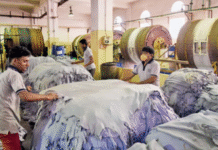The increase in the cost of fuel and fertiliser is a big pressure on the farmers. How can this be reduced?
The boro and aus crop production has been harmed this time. There was not enough rain during the monsoons. Aman production depends on water. With less rain, more irrigation was required. This undoubtedly put pressure on the farmers. The government has taken initiative regarding irrigation. In order to ensure irrigation, directives have been issued so that there is no load shedding in the rural areas. But only one third of the irrigation pumps are run with electricity in the country. The remaining two thirds run on diesel. The farmers are having to pay extra due to increased diesel rates. These two factors may have an impact. If the farmers want to cut costs, they will irrigate less and that will lead to less production. But if they pay more, production costs will go up and the price of paddy will increase. It will not be enough just to give consideration to irrigation pumps that run on electricity. Since two thirds of the pumps run on diesel, the government needs to turn its attention here too. The farmers must be spared from increased diesel costs.
How can the government do this?
This will require funds and this is not an easy task. The agriculture ministry has many projects. They can assess these projects in light of the present circumstances and see if costs can be cut from lesser important projects. Agricultural expositions or training programmes can be curtailed for the time being and the money saved from this can be used to relieve the pressure from the farmers. The agriculture ministry can also approach the government for funds. It must be kept in mind that the impact on agriculture due to the increase in diesel prices is not in any way the same as the impact on transport fare or industrial production. Agriculture cannot be compared with anything else. Important consideration must be given to the fact that the increase in diesel prices will impact agricultural, that is, food production.
Bangladesh is not self-reliant in food. Under these circumstances, it is a difficult task to ensure food security. The threat to food security remains.
If food security means that we can feed everyone in our country from domestic production, then I would say that over the past three or four years we have been in a more or less comfortable position where our staple food rice is concerned.
The impact of natural calamity and climate change was felt during the last boro season. Due to early floods, crops were damaged in Sylhet and the northern regions. Drought affected aman production. Now during the sowing of the aman crop, there is no rain. All this means there may be less rice production this time. If we are to pay attention to food security at the moment, we have to look into alternative ways and strategies. The government will have to think of where and how rice can be imported. Alternative sources must be sought. Taking initiatives in advance is the way to ensure food security in a country like ours.
So it must be imperative to have an accurate idea of how much rice will have to be imported or what shortfall will there be in rice production.
Accurate estimation is imperative. First of all, the stock of rice at various levels must be determined. This does not mean the government’s buffer stock alone. It must be determined how much rice may be produced. Various agencies in the agricultural sector carry out such tasks. They often have a propensity in inflating these figures. If there are errors in data, proper initiative cannot be taken. In the prevailing circumstances, it is not possible for the government to draw up an effective plan without accurate data. There are many farmers in the country who have the ability to stock rice. In calculating how much rice there is in stock in the country, the rice stocked with the rice mill owners must also be taken into consideration. Similarly, how much rice remains with the farmers, however little, must also be taken into account. If imports are carried out without accurate calculations, prices plummet in full season and the farmers bear the brunt of this. If the farmers face losses, they lose interest in cultivating rice the next season. So, having accurate data is vital to food security.
If food has to be imported due to low production, it will be difficult in the prevailing circumstances to arrange the funds required for the purpose.
The international market for food products is restive. It will require extra funds if food is to be procured from outside. The government is trying to arrange that financial assistance or loans for the purpose. In the prevailing situation, importance must be given to the market system. If domestic production is to be maintained, it must be ensured that the farmer can sell his produce at a profit. If the farmer does not get a profit, he won’t bother to produce anything. That is a threat for food security.
Crops have been damaged in the sudden floods this time. Aman production has been harmed due to less rain. How far is climate change connected to this?
What happened this year may not necessarily occur every year. From our experience we see that after every 10 years, agriculture is hit hard by natural calamities. This is nothing new. Climate change has become a big issue now. Actually every day changes are taking place in nature. The problems we are facing because of this must be resolved through technical innovation. Farmers in over 20 districts of our coastal areas are being harmed by tidal surges, salinity and embankments being damaged. Technology must be used to address these problems. This requires investment. Innovation is required. Climate change-tolerant seeds, salinity-tolerant seeds, drought-tolerant seeds, and flood-tolerant seeds must be developed. We must also take note that our farmers do not sit idle. They have undergone a psychological change. They are tackling the various problems on their own. But we need preparation and planning at a state level. The government is going ahead with the Delta plan, but so far the development partner countries have not given any assurance of technical or financial funds.
There is a forecast that food production may fall globally in the days to come. How realistic is this apprehension?
People refer to various sources and projections. FAO’s projection is that food production will not fall significantly. Wheat production may drop, but not rice production. Overall, there is no prediction of any crisis in the global market. The Ukraine war has created certain temporary crises. And various alternatives are emerging in the international market.
Bangladesh has limited land and a high population. This situation is worsening by the day. The population is going up, land is shrinking. How can this challenge be tackled?
This has no easy solution. There is no country with such a large population on such a small area of land. We know we must hold onto our croplands or else we will not be able to feed our people. Then again, if we want to hold on to this land, it will be hard to expand industrialisation and development infrastructure. We are in a dilemma. The fact remains that arable land will decrease in the days to come and we have to accept this. We have around 6 million hectares of arable land at present and this will drop to 5 million. We will have to step up our production on this land. We will have to turn to science for help. Whether it is agriculture, fish or livestock, we will have to increase our production per acre. We lag behind in egg production and in milk production too. We can increase production of both with higher quality breeds. The agricultural process must be made scientific to meet these challenges.
There is not much scope to create large farms in our agricultural system. Our privately owned agricultural plots are small and even those are being divided up. What is your observation or evaluation of this agricultural system?
There are around 17 million farmers in our country, 90 per cent of whom are small farmers. They have an average of less than 1 hectare each. In this system our farmers are producing the crops we require. This is the Bangladesh model. We have to go ahead with these farmers, this system. We note a lot of progress taking place. Many of our farmers cannot afford modern agricultural machinery. Under these circumstances, you will see that many entrepreneurs have sprung up in the rural area, providing agricultural services. Many educated and young entrepreneurs arrange funds, buy machinery and provide the farmers with service in exchange of money. A power tiller can be purchased for Tk 100,000 now. The entrepreneurs are buying these and providing services to the farmers. These emerging systems are very encouraging and these small farm systems are very effective.
Our agriculture is basically dependent on cultivation. How important is it to bring diversity to our agriculture. What are the benefits of this?
I feel that there is plenty of diversity in our agriculture at present. This diversity is imperative for our agriculture. It has all sorts of benefits. Firstly, diversifying crops instead of growing the same crops every year, increases the fertility of the land. Secondly, there are financial benefits. A farmer may face losses with one crop, but cover costs with another crop. If diversity increases in agriculture, overall risks decrease.










